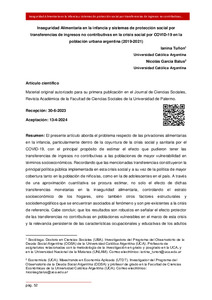Por favor, use este identificador para citar o enlazar este ítem:
https://repositorio.uca.edu.ar/handle/123456789/18076| Título : | Inseguridad Alimentaria en la infancia y sistemas de protección social por transferencias de ingresos no contributivas en la crisis social por COVID-19 en la población urbana argentina (2019-2021) | Autor : | Tuñón, Ianina Garcia Balus, Nicolás Alejandro |
Palabras clave : | VULNERABILIDAD; INFANCIA; TRANSFERENCIA DE INGRESOS; COVID-19; PANDEMIA; PROTECCION SOCIAL | Fecha de publicación : | 2024 | Editorial : | Universidad de Palermo. Facultad de Ciencias Sociales | Cita : | Tuñón, I., Garcia Balus, N. A. Inseguridad Alimentaria en la infancia y sistemas de protección social por transferencias de ingresos no contributivas en la crisis social por COVID-19 en la población urbana argentina (2019-2021) [en línea]. Journal de Ciencias Sociales. 2024, 22(1). doi: 10.18682/jcs.v1i22.9665. Disponible en: https://repositorio.uca.edu.ar/handle/123456789/18076 | Resumen : | Resumen: El presente artículo aborda el problema respecto de las privaciones alimentarias
en la infancia, particularmente dentro de la coyuntura de la crisis social y sanitaria por el
COVID-19, con el principal propósito de estimar el efecto que pudieron tener las
transferencias de ingresos no contributivas a las poblaciones de mayor vulnerabilidad en
términos socioeconómicos. Recordando que las mencionadas transferencias constituyeron la
principal política pública implementada en esta crisis social y a su vez de la política de mayor
cobertura tanto en la población de niños/as, como en la de adolescentes en el país. A través
de una aproximación cuantitativa se procura estimar, no solo el efecto de dichas
transferencias monetarias en la inseguridad alimentaria, controlando el estrato
socioeconómico de los hogares, sino también otros factores estructurales y
sociodemográficos que se encuentran asociados al fenómeno y son pre-existentes a la crisis
de referencia. Cabe concluir, que los resultados son robustos en señalar el efecto protector
de las transferencias no contributivas en poblaciones vulnerables en el marco de esta crisis
y la relevancia persistente de las características ocupacionales y educativas de los adultos de referencia de los niños/as, y las configuraciones familiares (monoparentalidad y cantidad
de niños/as en el hogar) que profundizan los riesgos sociales. Abstract: The present article addresses the issue of food deprivation in childhood, particularly within the context of the social and health crisis caused by COVID-19, with the main purpose of estimating the effect that non-contributory income transfers may have had on the socioeconomic vulnerability of populations. It is worth noting that these mentioned transfers constituted the main public policy implemented in this social crisis and, at the same time, the policy with the broadest coverage among both children and adolescents in the country. Through a quantitative approach, the aim is to estimate not only the effect of these monetary transfers on food insecurity, controlling for the socioeconomic stratum of households but also other structural and sociodemographic factors associated with the phenomenon that existed before the reference crisis. It can be concluded that the results robustly indicate the protective effect of non-contributory transfers on vulnerable populations in the context of this crisis, highlighting the persistent relevance of the occupational and educational characteristics of the adults responsible for the children and the family configurations (single parenthood and the number of children in the household) that exacerbate social risks. |
Cobertura Espacial: | Argentina | Cobertura Temporal: | SIGLO XXI | URI : | https://repositorio.uca.edu.ar/handle/123456789/18076 | ISSN : | 2362-194X | Disciplina: | SOCIOLOGIA | DOI: | 10.18682/jcs.v1i22.9665 | Derechos: | Acceso abierto |
| Aparece en las colecciones: | Colaboraciones en ediciones externas |
Ficheros en este ítem:
| Fichero | Descripción | Tamaño | Formato | |
|---|---|---|---|---|
| inseguridad-alimentaria-infancia.pdf | 1,39 MB | Adobe PDF |  Visualizar/Abrir |
Este ítem está sujeto a una licencia Creative Commons Licencia Creative Commons

